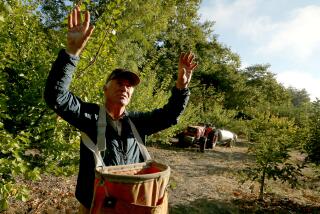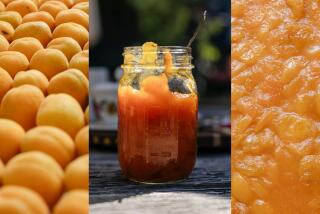Market Watch: The best in dried fruit
Dried fruit is both easier and trickier to enjoy than fresh fruit. Easier, because dried fruit is less perishable than fresh and is thus more readily shipped and stored. Trickier, because in addition to the factors that determine fresh fruit quality — variety, growing area, growing practices and ripeness — dried fruit quality depends on processing and storage. These sound simple but in fact involve artisanal practices that are not easy for producers to master and are largely inscrutable to consumers.
The upshot is that the best dried fruit is a big step up from commercial grade but little known and well worth searching out; supplies are often limited, and now is the time to lay in stores for late autumn through early spring, the prime season for consuming dried fruit. Below are my favorite dried fruits, along with sources and tips for getting and keeping them at their best.
Blenheim apricots
Bright orange, sweet-tart, with a distinctive musky perfume, dried Blenheims represent the best qualities of apricots because they are made from fruit that is fully ripe, at which point it is too delicate to ship fresh. Traditionally Blenheims were California’s signature dried fruit crop, other than raisins; in the late 1920s the state had 82,000 acres of apricots, and most were Blenheims grown for drying.
Plantings declined steadily in recent decades because of competition with lower-priced Turkish dried apricots, and there now are fewer than 1,000 acres of Blenheims left, mostly in San Benito and Santa Clara counties, southeast of San Jose. Only a few dry yards remain, and only a few scraps are left of the apricot orchards that once abounded in the Southland. It’s worth supporting the last local producers, such as K.B. Hall Ranch of Ojai (sometimes at the Santa Barbara and Ojai farmers markets), Forcefield Farm of Santa Paula (intermittently at the Hollywood and Santa Monica markets) and Savala Ranch of San Jacinto; but realistically the only steady sources for dried Blenheims are from up north, such as Gibson Farms and Gonzales Orchards of Hollister, which both sell by mail order.
The chief variables in dried apricots are size, texture, sulfuring and storage. Larger sizes bring premium prices; size only becomes a quality issue when the fruit is very small, at which point the texture is typically drier and there is a greater ratio of tough skin to tender pulp. Dry-farmed apricots (such as those from the three southern orchards mentioned above) are smaller and have a more concentrated flavor, but good Blenheims from irrigated orchards have plenty of intensity when dried. “Slabs” are extra-ripe, extra-sweet apricots that have lost their shape.
Sulfured fruit retains the bright color and distinctive flavor of fresh apricots, although soon after drying, if the concentration of sulfur is too high, it can cause some people to cough. Unsulfured apricots are a real treat for a few weeks after harvest, with the best of both worlds, great flavor and chemical-free; but they soon darken and develop a brown-sugar, figgy flavor that I personally like less than that of sulfured apricots.
Dried apricots keep fine at room temperature for a few weeks, but to make sure that they stay moist and retain their flavor, buy fruit that has been refrigerated and stored away from heat and sunlight, and keep it that way at home (ideally, take the fruit out of the refrigerator just before eating, which awakens the aroma); also, try to keep the bag tightly wrapped so that the moisture from the fruit does not leak out into air.
Flavor King Pluot and premium stone fruit
Great stone fruit varieties often (though not invariably) make great dried fruit, and the superb aroma and sweet-tart balance of the Flavor King Pluot, one of the best modern varieties, shines through in dried form. “Big Al” and Becky Courchesne of Frog Hollow Farm, from Brentwood in Contra Costa County, produce meaty, chewy dried Flavor Kings with intense, complex flavor; at $15 a pound, they’re not cheap, but they’re certified organic, and despite being unsulfured they retain their taste and appearance in the refrigerator.
Art Lange, the dean of farmers market stone fruit growers, also offers fine dried Flavor Kings, which are dipped in fruit juice and sun-dried without sulfur, an idiosyncratic approach that many people like. He (or rather, since Lange turns 89 today, his neighbor Ron Cornelsen) sells a wide range of dried stone fruit on occasional Sundays in the months before Christmas at the Beverly Hills farmers market and also by mail order (prices range from $8 to $20 per pound; be aware that the phone number listed on the website is incorrect, call [559] 240-6743).
Most commercial dried stone fruit is sold generically with no indication of variety; you’re basically buying a pig in a poke, because (particularly for white-fleshed varieties) you could be getting low-acid varieties, which are even more rubbery and tasteless dried than fresh. Lange, however, offers a bevy of excellent named varieties, such as tangy Cashmere yellow nectarine, intense Late Le Grand yellow nectarine, supersweet Emerald Beaut dried green plum and the apotheosis of high flavor in stone fruit, Snow Queen white nectarine. Happy birthday and kudos to you, Art!
Snow Queen white nectarines (shhh!)
It is with very mixed feelings that I dare to mention the best dried stone fruit in the world, the sulfured Snow Queen white nectarine produced by Truman and Betty Kennedy of Dinuba. At its best, the fresh fruit has a perfect balance of sweetness and acidity, and an intense, lingering, complex flavor. Alas, only a small percentage of the fruits reach this peak, and although selected dried Snow Queens are matchless in quality — meaty, sweet, tangy, floral, almost gamy, they’re so rich in flavor — they are available in very limited quantities, and intermittently, at the Santa Monica farmers market, for about $18 a pound.
Whence my ambivalence about telling the world of this treasure. In addition, although the Kennedys store their dried fruit properly refrigerated, at farmers markets it is displayed in plastic tubs that are sometimes exposed for hours to the hot sun; I’d advise scrutinizing the fruit for signs of discoloration or off-flavors before buying. Finally, Truman, an amiable bear of a man, sells the Snow Queen variety as “Stanwick,” which is a different, historic variety that was the leading dried white nectarine in California 50 years ago; the story of its misidentification as Snow Queen is as long and complex as its flavor.
Calmyrna natural dried figs
The Calmyrna fig is large, very sweet and rather bland as a fresh fruit, but when dried it develops a rich, honeyed, nutty flavor that makes it the standard of quality in dried figs. The rarest and finest specimens are so-called naturals, which, unlike commercial specimens, have not been rehydrated or treated with preservatives. Paul and Kathy Mesple, who are based in Fresno and farm in Chowchilla, offer prime, select naturals: large, gorgeous, dried Calmyrnas straight from the drying yard, with a firmer, slightly drier skin than rehydrated fruits, and a clean, sweet fig flavor that can’t be beat. Order them directly from the Mesples at (559) 439-0104 or [email protected]; they’re $7 a pound, plus shipping, with a minimum order of 5 pounds, and typically sell out by Thanksgiving.
More to Read
Eat your way across L.A.
Get our weekly Tasting Notes newsletter for reviews, news and more.
You may occasionally receive promotional content from the Los Angeles Times.










